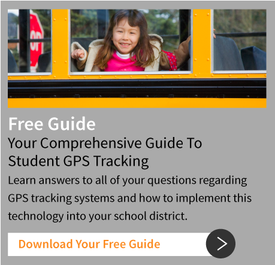5 Questions You Must Ask When Implementing Student GPS Tracking
published on March 24, 2015 by Sonia Mastros
 The choice to implement student GPS tracking within your school district is a major decision that requires a great deal of dialogue among administrators and other school district employees. Understandably, those in charge of making the decision on student tracking software and bus routing programs want to know they are asking the right questions, and most importantly, getting answers.
The choice to implement student GPS tracking within your school district is a major decision that requires a great deal of dialogue among administrators and other school district employees. Understandably, those in charge of making the decision on student tracking software and bus routing programs want to know they are asking the right questions, and most importantly, getting answers.
It’s often helpful to create a checklist prior to any discussions surrounding student and bus tracking programs, so no significant topic goes unexamined. Once you settle on investing in these programs, it’s especially important to pay attention to details.
How do you know if you’re asking the right questions? To ensure the success of your student GPS tracking and school bus routing software, make sure to include the following questions on your overall checklist.
1. What is the best option for student IDs?
When implementing student GPS tracking, school districts have a number of student ID options to choose from. Identifications may be made by scanning cards that have a bar code or RFID chip, key fobs, thumbprints or even an eye scanner. Cards are relatively inexpensive to replace, but a key fob is more costly.
Many administrators choose key fobs as the primary student ID because of the long-distance tracking benefits. Readers are placed next to doors students may use to leave school early or in exterior areas, so key fobs hanging from a student’s bag can be read without the need to be close to the reader.
2. What is required of students?
While there are financial benefits to using student tracker and bus routing software, most school districts choose to implement student GPS tracking programs for the benefit of monitoring their students’ whereabouts.
Students may be expected to carry their personal ID with them in order to check onto the bus, into school and within specific spaces on school property. Student IDs have the potential to prevent students from accessing restricted areas or exiting the building in order to skip class.
3. How will parents react to student GPS tracking?
Most parents are supportive of measures a school district might take to protect their children, but it’s always possible that some parents may raise concerns. In order to address parents in a helpful, productive way, keep in mind that student GPS tracking and bus routing software are specifically designed to improve safety.
Student tracker programs ensure that children are supervised during the hours the school district is responsible for them. Bus tracking programs also enable administrators to make sure students are transported safely.
4. Should I choose a cellular- or radio-based service?
Because a radio-based service is less expensive, school administrators often choose this option as a substitute for cellular-based service. Continue reading to learn more about each option:
Radio-Based Service
Radios don’t require a monthly cell service, but the frequency and distance signals are able to travel is limited, and the process takes more time. Radio service usually requires serial port readers that are placed on top of buildings to collect radio waves.
Cellular-Based Service
Alternatively, cellular service is compatible with consumer cellular networks, including 3G and 4G providers, as long as the service is available within the school district’s area. It’s possible to save money on a cellular service by committing to a network’s data plan rather than cell service, which may make cellular service a more attractive option.
5. Which bus routing program should I choose with student GPS tracking?
Once you install the necessary hardware, software options depend on the equipment you use. Before choosing from your software options, it’s important that a local, certified installer set up your hardware. If your installer is not certified, you may lose warranties on school buses.
School bus routing software allows users to view different routes and overlay where the bus is traveling in order to monitor routing deviations. Among a number of other options, student GPS tracking programs can notify staff if a student gets off at the wrong stop, never gets off the bus at all or doesn’t get on the bus.
Choosing new software is never an impulsive decision, especially when the decision affects the safety of children whose care is in your hands during every school day.
By asking the five questions posed here and discussing the answers among decision-makers in your school district, you gain a deeper understanding of what software for mapping school buses and student GPS tracking programs best suit your needs.
Are you ready to consult an industry professional with any additional questions you may have about student GPS tracking? Call 866-740-8994 to speak with a specialist or click here to request more information. 





